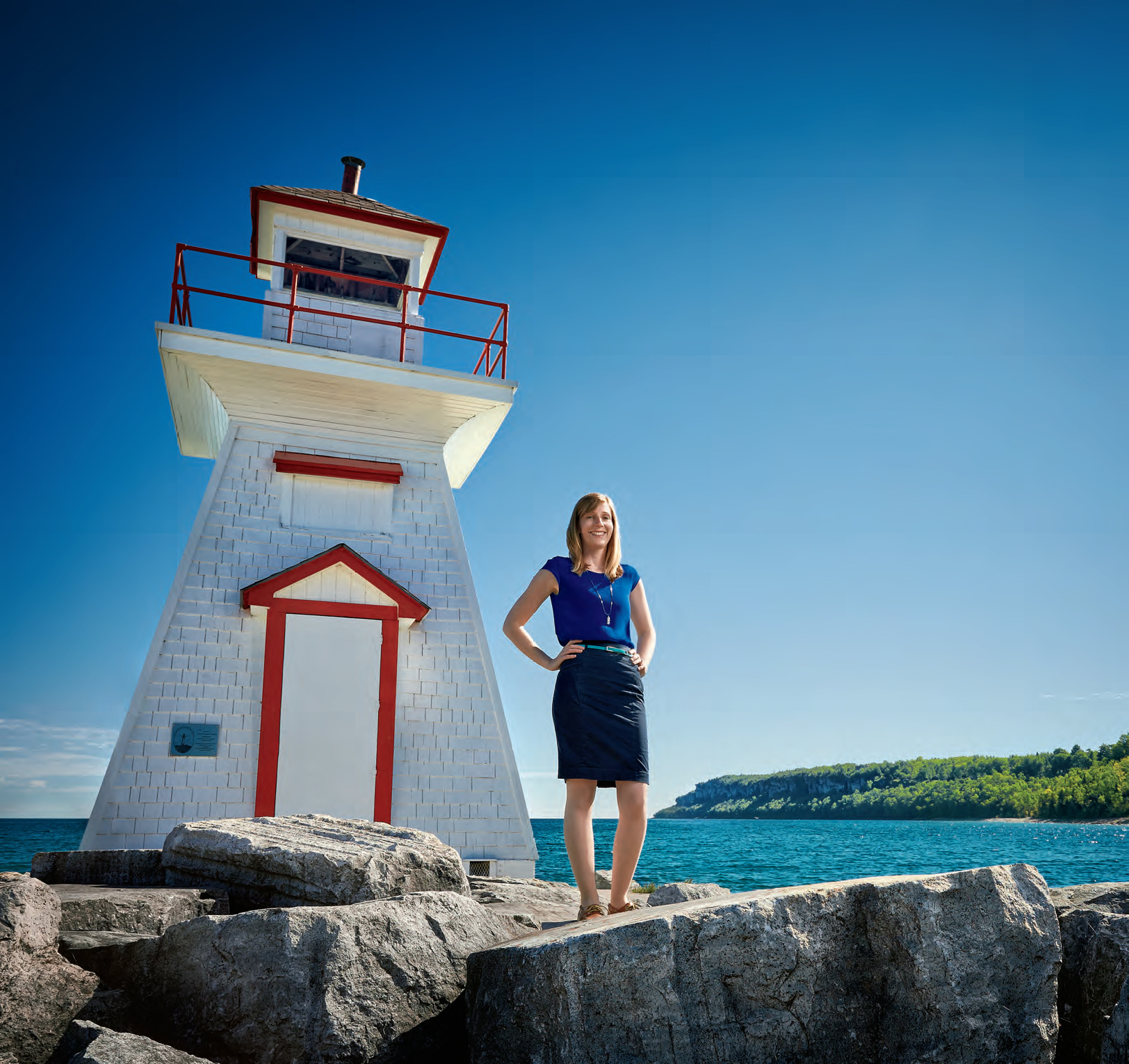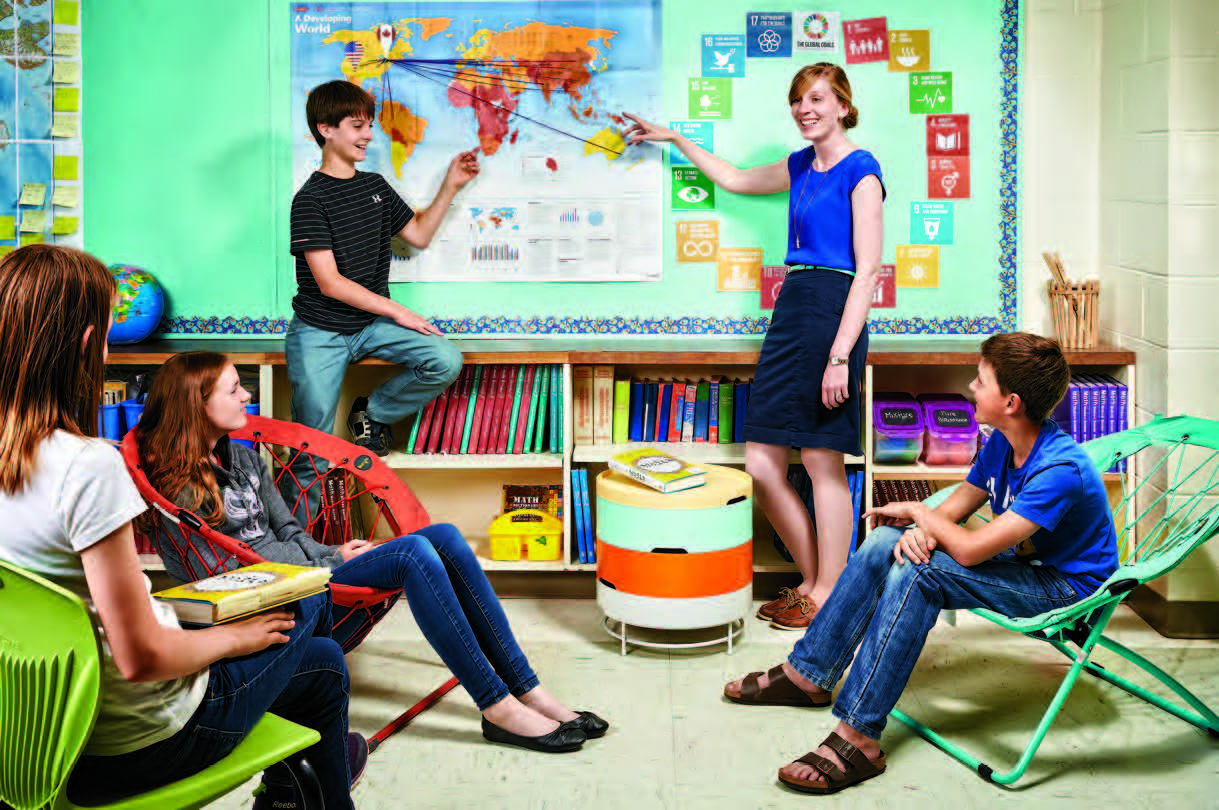Share this page

Breanna Myles, OCT, explores world issues and encourages global awareness in her Grade 7/8 geo-literacy classroom.
By Trish Snyder
Photos: Matthew Liteplo
To view our Great Teaching video archive, visit oct-oeeo.ca/1Kwel5r
It’s a brisk spring morning in Lion’s Head, Ont., and roughly two dozen students are raising their eyebrows in amazement over their teacher’s request. Breanna Myles, OCT, has instructed her Grade 7/8 class at Bruce Peninsula District School (part of the Bluewater District School Board) to write their names on scraps of paper, then crumple them up. “When I call your name, please stand and try to throw your piece into this bin,” she says, pausing to let the excitement build up, then simmer down. “Here’s the catch — you only get one shot and you can’t move away from your desk.”
One by one, the students let ’em fly. A girl sinks hers and triumphantly raises her hands. Another overshoots; two more fall short, followed by a boy at the back who twirls, launches and misses. A girl on the far side of the room leans forward to get a better shot, then squirms with frustration after her wad lands on the floor. “I can’t even see the bin!” she complains.
Myles asks the 11 students who hit the target to remain standing while the 14 others take their seats. “Can anyone tell me what we just saw?” “That we have better basketball skills,” jokes one boy. “That depending on where you are in relation to the bin, it makes it easier,” suggests one girl. “The people at the front of the class have a better chance because they’re closer.”
“Yes!” says Myles, deftly steering the discussion toward the book they’ve been reading, Chelsea Clinton’s It’s Your World: Get Informed, Get Inspired & Get Going. “Remember we talked last time about health care around the world? Let’s imagine this: if you’re standing up, you have access to vaccines, doctors and hospitals. If you’re sitting, sorry, you don’t. Is it fair that some have a better chance simply because of where they’re born?” While a volunteer cleans up the paper littering the floor, Myles lets this idea sink in — that geography can influence your future.

As a child, Myles herself attended this very school, perched halfway up the Bruce Peninsula (one of the world’s UNESCO biospheres) — so she knows how tempting it is to live in a blissful bubble surrounded by the spectacular Georgian Bay landscape. Instead, the elementary teacher points her students’ gaze outward to world issues, empowering them to make a difference. Earlier this year, she was named a National Geographic Grosvenor Teacher Fellow for her geo-literacy work in the classroom. Selected from more than 700 applicants, Myles had the opportunity to join an expedition to the Arctic to develop teaching materials; visit her blog at oct-oeeo.ca/28LUhJW.
“This intermediate age group can be seen as self-absorbed,” admits Jodi Naves, OCT, the school’s acting vice-principal whose son is in Myles’s class. “Breanna is so good at finding creative ways to get them engaged and thinking about others.”
Travelling abroad helped to ignite Myles’s passion for global awareness and education. As an undergrad in international development, she completed fieldwork at schools in Uganda, Kenya and Tanzania — observing classrooms packed with 40 to 50 eager children. Later, as a student teacher, she taught English to girls in Ecuador. “I saw how transformative education could be, how learning English empowered these girls to pursue their dreams. Those experiences made me want to do something about the inequalities I was seeing.”
So she made it her mission to give students a global perspective by shaping the school year around a big idea. Her “Think Locally, Act Globally” theme emerged after the UN released its 2015 Global Goals for Sustainable Development (globalgoals.org) to end poverty, combat climate change and fight injustice and inequality by 2030. “A theme gives a lens through which to look at the curriculum for the year,” says Myles. “Students want to see connections between what they’re learning and what’s going on in real life.” That means the class is globally minded across almost every subject. In math, for example, Myles had them practise their graphing skills by comparing data on life expectancy, education and income for developed and developing nations. They learned how to write about subjects from different perspectives by pairing up to research and debate climate change — one partner argued that global warming is a scientifically proven reality while the other claimed that climate change is a myth.
She spins lessons around the current events young people are paying attention to. “My fiancé is always bugging me about spending so much time planning: ‘Don’t you have this lesson from last year?’” says Myles. “But what was going on then isn’t going on now. Whenever I can make a real-world connection, I know they’ll be more engaged.” When they showed interest in last fall’s federal election, she had the class complete the Vote Compass questionnaire (votecompass.com) to learn which party their views aligned with, then they researched where every party stood on issues such as health care and the economy. Around the same time, a local MP spoke out against what he felt was an unrealistic timeline for welcoming fleeing Syrians to Canada, which triggered lively discussions around immigration. A girl in Grade 7 wasn’t the only one asking, “Why do we have to take them in? Aren’t they going to take all of our jobs?” Many felt differently after Myles played an animated YouTube video that explained the facts surrounding the refugee crisis. When that MP visited Myles’s classroom, the students asked him tough questions. And, what of that girl? Now she wants to be a human rights lawyer. “I want them to be critical thinkers,” says Myles. “Don’t just take what people say at face value — and that includes me. Listen to viewpoints, learn the facts and make up your own mind.”
To foster those skills, Myles favours assignments that provoke higher-order thinking. She often gives students a say in which activities they’ll do and involves them in defining the success criteria. As she says, “I don’t want to read the same book report 25 times!” For a final assignment on The Breadwinner — an award-winning novel about an 11-year-old who disguises herself as a boy to support her family in war-torn Afghanistan — they crafted Jeopardy-style games, rewrote the story’s ending and designed alternative book covers. “I find that when you give choices, they take ownership and produce work that’s of higher quality,” she says. In science, they staged a mock Dragon’s Den: the Grade 7s pitched ideas for inventions that would help people in developing nations transport water from faraway wells; one involved strapping a water bucket to a repurposed stroller.
“Breanna gets right into the curriculum and looks for experiences that make students better critical thinkers,” says principal Kim Kaufman-Harbinson, OCT “I’m always getting emails late at night or on weekends when she’s coming up with awesome lessons, activities and field trips.”
Kaufman-Harbinson says that no teache organizes more outings than Myles — who likes to take students off school property to better create links with the community. They go for runs on the Bruce Trail, curl at the local rink and visit the public library. On trips to Ottawa and Toronto, she arranged meetings with their MP and MPP so students know who to contact if they want to write letters on subjects they care about. They learned about the natural gem in their own backyard on a camping overnight in Bruce Peninsula National Park, where a boy who struggled in class due to a mild intellectual disability flourished outdoors. “These trips are so important to show that learning doesn’t just happen inside four walls,” says Myles.
When inside those walls, Myles leans heavily on technology. The fifth-year teacher uses minimal paper (crumpled paper-toss notwithstanding), projecting lessons on her whiteboard. Google Classroom (classroom.google.com) eliminates the curse of forgotten binders and allows everyone to submit and access work online with classroom iPads. She relies on Sesame (sesamehq.com) for assessment — students can upload photos and videos of their work to show how, for example, they solve a math problem. Google Cardboard (oct-oeeo.ca/1UnU7sl) is a $15 viewer that simulates a virtual reality experience that practically transports the teens by retracing their teacher’s steps in the Arctic. “Technology allows me to bring the world to them in ways I can’t do by simply talking. Videos and images are as close as I can give them to a real-life experience.”
If the class’s culminating projects are any indication, the messages about global citizenship are getting through. At a May assembly for the whole school, the young people presented their plans for taking local action on a global issue. One student orchestrated a basketball-athon to collect money for sports equipment in connection with the UN Global Goal for good health. Another staged a community potluck and food drive to raise awareness about ending hunger. “I can’t just tell them to care — that doesn’t work,” says Myles. “I empower them with information because I believe that awareness will be enough to inspire them to take action. I think that’s the best thing I can do as a teacher.”
The OCT featured in this department has been recognized with a national teaching award and exemplifies the high standards of practice to which the College holds the teaching profession.
Since National Geographic Grosvenor Teacher Fellow Breanna Myles, OCT, can’t fly her class to the developing world, she travels online to look for ways to simplify big issues, bring ideas to life and make learning fun. Check out her favourite web checkpoints en route to creating global citizens.
Myles uses YouTube (youtube.com) daily. But instead of just browsing, she bookmarks what she encounters on sites like Reddit (reddit.com) and Upworthy (upworthy.com). She also subscribes to YouTube channels set up by UN Global Goals, non-government organizations, etc.
Canadian Geographic (canadiangeographic.ca) and National Geographic (nationalgeographic.com) offer teacher resources and lesson plans. Myles’s students follow the Classroom Energy Diet Challenge (energydiet.canadiangeographic.ca), which aligns with Grade 7 geography.
Celebrity voiceovers grab the attention of young people, while gripping stories about the power of girls’ education around the world draw them in to this documentary, which Myles screens to illustrate gender inequality. Get teaching resources at girlrising.com.
Visiting developing nations teaches the impact of being there. Myles brings students as close as possible with Google Street View photos (google.com/ maps/streetview). These images from around the world are presented alongside photos, videos and 360-degree views that have been uploaded by users.